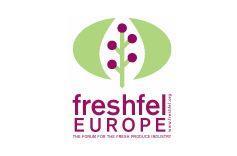
A new report containing updated fresh produce export data has revealed that while European Union (EU) fresh fruit exports climbed considerably in 2009, the value of these shipments dropped sharply, as did both the volume and value of EU vegetable exports.
The report, based on Eurostat data and compiled by European fresh produce association Freshfel Europe, showed that fruit export volumes to third countries jumped 11.9 per cent through the year to hit 2.8m tonnes, while the value of those exports slid 7.2 per cent to €1.9bn.
'Combining these two figures, one should have a careful reading of the growth in volume given the lower returned value,' said Philippe Binard, general delegate of Freshfel Europe. 'EU exporters have remained handicapped by the high value of the euro on the external market as well as the lack of support mechanisms, such as export credit schemes and export refunds that the EU dismantled with the latest CMO reform.
'Looking at the value per kg exported, it had decreased by €0.15 per kg on average for fruit from €0.84 per kg to €0.69 per kg,' Mr Binard added. 'This is an alarming situation.'
Russia remained the largest third-country export market for the EU, accounting for 38 per cent of the overall exported volume, followed by Ukraine with 12.8 per cent, Switzerland with 10.2 per cent and Norway with 6.4 per cent.
By category, apples remained the most-exported fruit last year at over 1.1m tonnes, up 26 per cent on 2008, followed by oranges at 240,935 tonnes, and then pears.
'While the exported volume remained steady mainly due to the demand on the Russian market for fruit, one should also look at the breakdown of the global EU volume,' Mr Binard continued. 'Indeed, some important variations occurred among the member states and by products. The growth in 2009 was mainly driven by the strong development of Polish apples to the Russian market which has hidden the decline experienced by some other traditional exporting member states.'
By contrast, exported vegetable volumes to third countries in 2009 dropped by 7.68 per cent on the previous year, and fell 12.39 per cent in value terms. This did, however, represent an increase on the five-year average of 12.72 per cent in volume terms and 9.65 per cent in value terms, Freshfel noted.
Russia, with 28.7 per cent of the overall market, was again the main importing nation, followed by Switzerland at 10.6 per cent, Senegal at 8.7 per cent and Norway (6.2 per cent).
'Russia is the leading destination for EU fresh produce. EU exporters should however continue diversifying their markets and open new markets, particularly in Asia,' said Willem Baljeu, chairman of the Freshfel export division.
'Today, China and India account for less than 5,000 tonnes of EU exports, when they represent one-third of the world population and two of the fastest growing markets,' Mr Baljeu added. 'More efforts need still to be undertaken at EU level to move towards greater reciprocity in trade, to tackle technical barriers to trade such as SPS measures, and also look at some other important aspects such as competitiveness and promotions.'



